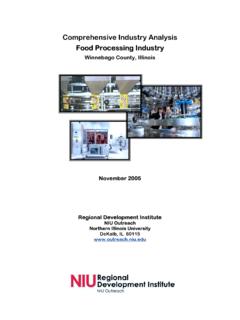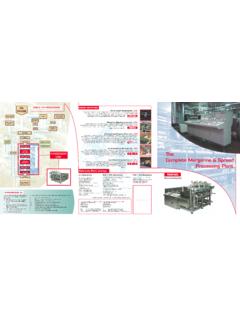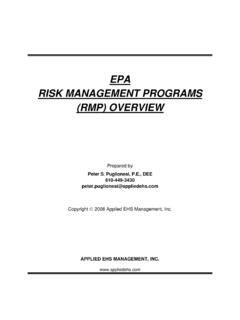Transcription of Appropriate food packaging solutions for …
1 Study conducted for the International CongressSAVE food !at Interpack2011 D sseldorf, GermanyRural Infrastructure and Agro-Industries Division (AGS) food and Agriculture Organization of the United NationsViale delle Terme di Caracalla, 00153 Rome - : +39 06 57053057 SAVE FOODAn initiative of Messe D sseldorf in collaboration with food packaging solutions for developing countriesnew editionI3684E/1 978-92-5-108235-5978 9251082355 food AND AGRICULTURE ORGANIZATION OF THE UNITED NATIONSRome, 2014byNerlita M. ManaliliIndependent ConsultantRegional Adviser on Market Access & Sustainable Agricultural Chain Development in AsiaThe PhilippinesandMoises A. DoradoUniversity of the PhilippinesRobert van OtterdijkFAORome, ItalyStudy conducted for the International CongressSAVE food !at Interpack2011 D sseldorf, GermanyAppropriAte food packaging solutions for developing countriesThe designations employed and the presentation of material in this informationproduct do not imply the expression of any opinion whatsoever on the part of theFood and Agriculture Organization of the United Nations (FAO) concerning the legalor development status of any country, territory, city or area or of its authorities, orconcerning the delimitation of its frontiers or boundaries.
2 The mention of specificcompanies or products of manufacturers, whether or not these have been patented,does not imply that these have been endorsed or recommended by FAO in preferenceto others of a similar nature that are not views expressed in this information product are those of the author(s) and do notnecessarily reflect the views or policies of 978-92-5-108235-5 (print)E-ISBN 978-92-5-108236-2 (PDF) FAO, 2014 FAO encourages the use, reproduction and dissemination of material in this informationproduct. Except where otherwise indicated, material may be copied, downloaded andprinted for private study, research and teaching purposes, or for use in non-commercialproducts or services, provided that Appropriate acknowledgement of FAO as the sourceand copyright holder is given and that FAO s endorsement of users views, products orservices is not implied in any requests for translation and adaptation rights, and for resale and other commercialuse rights should be made via or addressed information products are available on the FAO website ( )and can be purchased through CITATIONFAO.
3 2014. Appropriate food packaging solutions for developing countries. edition: FAO. 2011. Appropriate food packaging solutions for developing countries. photo: Cover design:Simone MoriniiiiContentsPreface ivExecutive summary v1. Introduction 12. The global packaging industry industry composition Supply side - by nature of end product Supply side - by form and type of packaging material Demand side - by end user product or industry 43. food packaging in developing countries status and trends Volumes of trade Meeting the needs of commodity chains Market access and integration into sustainable value chains packaging technology drivers and trends Regional dimensions of growth The state of regional development Investment opportunities in developing countries 84.
4 food packaging solutions in developing countries Addressing food losses in the value chains Trade policy and legislation Trade with industrialized regions Product and technology development Upgrading packaging technology Competitiveness of small and medium enterprises (SMEs) Pre-packing and contract packing Recycling of packaging material packaging machinery Creativity, innovations and initiatives 195. Concluding statements 23 References 25ivPrefaceThis publication is based on a study carried out by Ms Nerlita M. Manalili from May 2010 to February 2011, upon a request from the food and Agriculture Organization of the United Nations (FAO).The study was undertaken to serve as a basis for the international congress Save food !
5 , taking place from 16 to 17 May 2011, at the international packaging industry fair Interpack2011 in D sseldorf, Germany. Save food ! has been co organized by Interpack2011 and FAO, aiming to raise awareness on global food losses and waste. In addition, Save food ! brings to the attention of the international packaging industry the constraints faced by the small- and medium-scale food processing industries in developing countries to obtain access to adequate packaging materials which are economically revised edition, dated 2014, contains a new section on investment opportunities in developing countries (paragraph ).Special thanks go to Prof Angela Cielo and Ms Imelda Valenton for their research support, to Engr. Eduardo Manalili, for his editorial support, to Simone Morini for the cover design and to Larissa D Aquilio for the desktop publishing and graphic project summaryThe study assesses the state of packaging and packaging technologies in developing countries, with the challenge of global food losses and the potential for agri- food systems as the backdrop.
6 The purpose of the exercise is to identify packaging solutions in developing countries, within the limits of prevailing levels of development and conditions, and in an attempt to make better use of the locally available packaging materials. This is done within the framework of developing countries role as major supplier to the global food system and, consequently, as contributor to the search for global food loss of the study are as follows:On the status of packaging industry sectors in developing countriesThe food packaging industry sector of developing countries derives its strength from the large volume of agricultural production, the steady growth in food commodities and the continually increasing food demand fuelled by rising incomes. industry limitations that beset the packaging sector across developing regions include limited packaging solutions to meet international market requirements, and the small size of the domestic demand for packaging materials that consequently leads to low investment by the packaging industry .
7 This, in turn, limits developing countries ability to enhance product quality to meet standards of increasingly discriminating consumers, both in domestic and international the packaging sector s opportunities and potential in developing countriesAs many products exported to developed countries are already processed at point of origin, the demand for these to be packaged in retail friendly form is on the rise and this is an opportunity for the developing economies to take advantage of. Of the three subsectors of the packaging industry (manufacturing, machinery and service), there appears greatest potential to develop package manufacturing in developing countries, given the tendency to process nearer to the production source and the availability of paper and paper board packaging materials.
8 As to packaging machinery, creativity in coming up with locally designed equipment suited to local needs and conditions will help propel packaging industry development. While this strategy is in its infancy, developing countries will mainly have to rely on second-hand machines with their lower cost offsetting the cost of maintenance. This is because of the prohibitive cost of brand new ones. Developing the packaging service provision subsector, specifically pre-packing of food products for export, and outsourcing the packaging of food products to specialized companies, will provide a much-needed boost to the packaging industry in developing countries. They will not only lend affordability of packages and packing but will likewise enhance handling and distribution efficiencies to exporters, specifically to SMEs.
9 On addressing the low investment in packaging industries in developing countriesInitiatives towards growth of packaging industries in developing countries may come either from improving traditional technologies or importing new ones. However, more relevant than the appropriateness and balance of the selected mix of strategies, the success of these initiatives will be contingent on a country s enabling environment, both economic and political. As packaging materials are in short supply in developing countries, relaxing packaging regulations without sacrificing food safety considerations may assist the industry to develop. An example is allowing the use of recycled packaging materials when they pose no problem of contamination ( for use with dried foods). Such relaxation of packaging standards will help increase supply of packaging materials while at the same time addressing food loss concerns.
10 While prospects are bright for the growth of the packaging industry sector, it will be for the good of the industry , the stakeholders comprising it and society at large, if focused packaging solutions , taking into account sustainability concerns, are provided to meet the sector s needs. This will not only bring about cost savings but will likewise be good for the IntroductionAbout one billion people were living in hunger across the globe in 2009, which was about 100 million people more than the 2008 level (World Summit on food Security, 2009). While addressing global hunger through further investment in food production is a welcome move, it should be complemented with a food loss reduction strategy, as reducing losses is among the most sustainable alternatives to increasing food production (UNEP/GRID-Arendal, 2010) and is a way to advance food security as well as to feed the large losses from farm to plate are attributed to poor handling, distribution, storage, and purchase/ consumption behavior.














